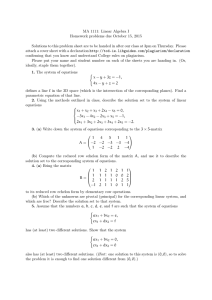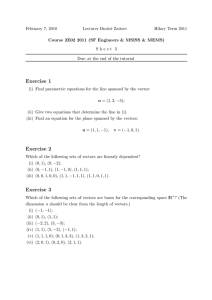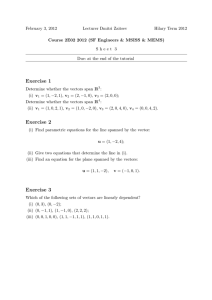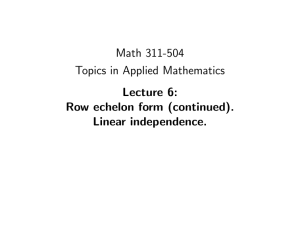MA 1111: Linear Algebra I
advertisement
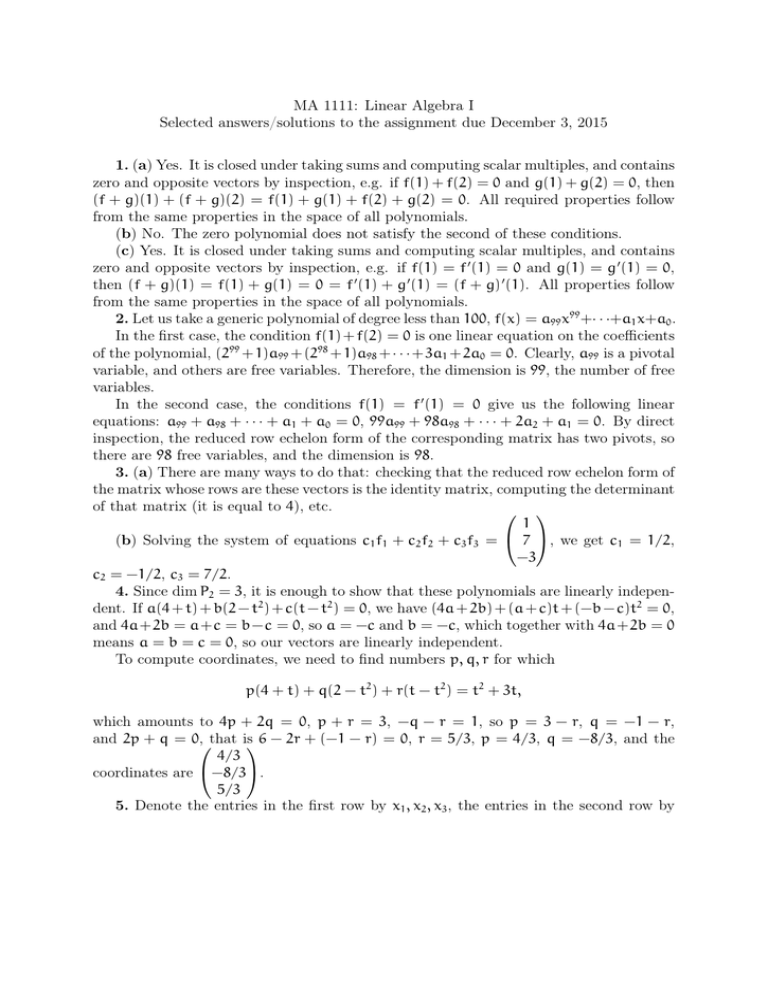
MA 1111: Linear Algebra I Selected answers/solutions to the assignment due December 3, 2015 1. (a) Yes. It is closed under taking sums and computing scalar multiples, and contains zero and opposite vectors by inspection, e.g. if f(1) + f(2) = 0 and g(1) + g(2) = 0, then (f + g)(1) + (f + g)(2) = f(1) + g(1) + f(2) + g(2) = 0. All required properties follow from the same properties in the space of all polynomials. (b) No. The zero polynomial does not satisfy the second of these conditions. (c) Yes. It is closed under taking sums and computing scalar multiples, and contains zero and opposite vectors by inspection, e.g. if f(1) = f 0 (1) = 0 and g(1) = g 0 (1) = 0, then (f + g)(1) = f(1) + g(1) = 0 = f 0 (1) + g 0 (1) = (f + g) 0 (1). All properties follow from the same properties in the space of all polynomials. 2. Let us take a generic polynomial of degree less than 100, f(x) = a99 x99 +· · ·+a1 x+a0 . In the first case, the condition f(1) + f(2) = 0 is one linear equation on the coefficients of the polynomial, (299 + 1)a99 + (298 + 1)a98 + · · · + 3a1 + 2a0 = 0. Clearly, a99 is a pivotal variable, and others are free variables. Therefore, the dimension is 99, the number of free variables. In the second case, the conditions f(1) = f 0 (1) = 0 give us the following linear equations: a99 + a98 + · · · + a1 + a0 = 0, 99a99 + 98a98 + · · · + 2a2 + a1 = 0. By direct inspection, the reduced row echelon form of the corresponding matrix has two pivots, so there are 98 free variables, and the dimension is 98. 3. (a) There are many ways to do that: checking that the reduced row echelon form of the matrix whose rows are these vectors is the identity matrix, computing the determinant of that matrix (it is equal to 4), etc. 1 7 , we get c1 = 1/2, (b) Solving the system of equations c1 f1 + c2 f2 + c3 f3 = −3 c2 = −1/2, c3 = 7/2. 4. Since dim P2 = 3, it is enough to show that these polynomials are linearly independent. If a(4 + t) + b(2 − t2 ) + c(t − t2 ) = 0, we have (4a + 2b) + (a + c)t + (−b − c)t2 = 0, and 4a+2b = a+c = b−c = 0, so a = −c and b = −c, which together with 4a+2b = 0 means a = b = c = 0, so our vectors are linearly independent. To compute coordinates, we need to find numbers p, q, r for which p(4 + t) + q(2 − t2 ) + r(t − t2 ) = t2 + 3t, which amounts to 4p + 2q = 0, p + r = 3, −q − r = 1, so p = 3 − r, q = −1 − r, and 2p + q = 0,that is6 − 2r + (−1 − r) = 0, r = 5/3, p = 4/3, q = −8/3, and the 4/3 coordinates are −8/3. 5/3 5. Denote the entries in the first row by x1 , x2 , x3 , the entries in the second row by x4 , x5 , x6 , and the entries in the third row by x6 , x7 , x8 . We have x1 + x2 + x3 = x4 + x5 + x6 , x4 + x5 + x6 = x7 + x8 + x9 , x1 + x4 + x7 = x2 + x5 + x8 , x1 + x4 + x7 = x3 + x6 + x9 , x1 + x2 + x3 = x3 + x6 + x9 which gives us five equations involving 9 unknowns. One can compute the reduced row echelon form directly, but let us show how to reduce computations a little bit. Clearly, the last equation is redundant since the sum of all rows is equal to the sum of all columns, so we can keep the first four equations. Since there are four equations, the number of leading variables is at most 4, the number of free variables is at least 5, and the dimension is at least 5. To show that the dimension is equal to 5, it is enough to show that 5 coordinates are enough. Let us assign arbitrary parameters to x5 , x6 , x7 , x8 , and x9 , then from the last row we know what the row/column sum is equal to, from the last column we recover x3 , from the second row we recover x4 , and from columns we recover the first two x1 and x 2 . 1 −1 0 1 0 −1 −1 1 1 This leads to the following basis vectors: −1 1 0, −1 0 1 , 1 0 0, 0 0 0 0 0 0 1 0 0 0 0 1 0 1 0 1 0 0, 1 0 0 (numbers in bold are values of free variables, — notice that 0 1 0 0 0 1 these correspond to standard unit vectors in R5 .

